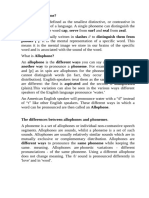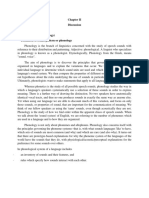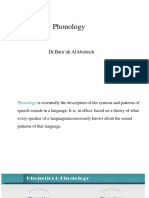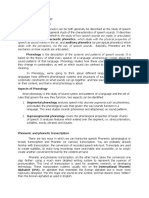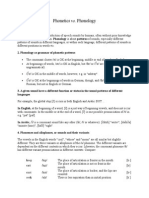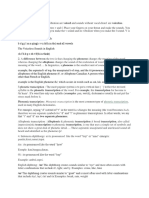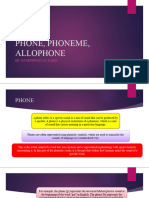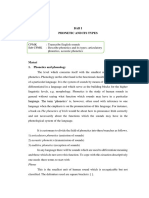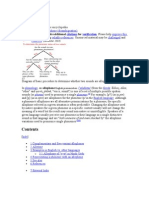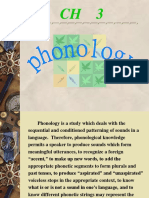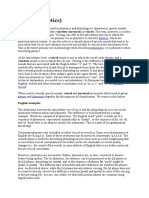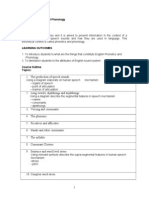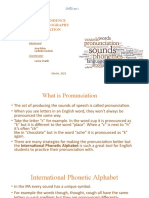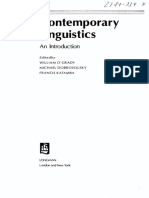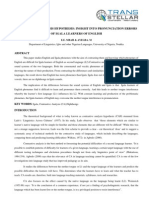0 ratings0% found this document useful (0 votes)
46 viewsBroad and Narrow Transcription
Broad and Narrow Transcription
Uploaded by
rody.rodina36Copyright:
© All Rights Reserved
Available Formats
Download as DOCX, PDF, TXT or read online from Scribd
Broad and Narrow Transcription
Broad and Narrow Transcription
Uploaded by
rody.rodina360 ratings0% found this document useful (0 votes)
46 views2 pagesOriginal Title
broad and narrow transcription
Copyright
© © All Rights Reserved
Available Formats
DOCX, PDF, TXT or read online from Scribd
Share this document
Did you find this document useful?
Is this content inappropriate?
Copyright:
© All Rights Reserved
Available Formats
Download as DOCX, PDF, TXT or read online from Scribd
Download as docx, pdf, or txt
0 ratings0% found this document useful (0 votes)
46 views2 pagesBroad and Narrow Transcription
Broad and Narrow Transcription
Uploaded by
rody.rodina36Copyright:
© All Rights Reserved
Available Formats
Download as DOCX, PDF, TXT or read online from Scribd
Download as docx, pdf, or txt
You are on page 1of 2
Transcribing phones
When we describe phones, we use narrow transcription (to include
as many aspects of a specific pronunciation as possible) and place the
letters and symbols between two square brackets ( [ ] ). Phonetic
(narrow) transcriptions give us lots of information about how to
physically produce sounds.
For example, the word 'port' has an audible exhalation of air after the
letter 'p'. This is shown in the phonetic transcription with a [ʰ] and the
word port in phonetic transcript would look like this [pʰɔˑt].
Let's take a look at some more examples of phonetic transcription.
Head - [ˈhɛd]
Shoulders- [ˈʃəʊldəz]
Knees - [ˈniːz]
And - [ˈənd]
Toes - [ˈtəʊz]
Transcribing phonemes
When describing phonemes, we use broad transcription (only
mentioning the most notable and necessary sounds) and place the
letters and symbols between two slashes ( / / ). For example, the
English word apple would look like this /æpəl/.
Here are some further examples of phonemic transcriptions
Head - / hɛd /
Shoulders - / ˈʃəʊldəz /
Knees - / niːz /
And - / ənd /
Toes - / təʊz /
As you can see, both transcriptions are very similar, as they follow the
IPA. However, look closely, and you will see some diacritics in the
phonetic transcriptions that do not appear in the phonemic
transcriptions. These diacritics provide a few more details about
how to pronounce the actual sounds.
What is Allophone?
An allophone is the different ways you can say a word or basically
another way to pronounce a phoneme. For example, [pʰ] as in pin
and [p] as in spin are allophones for the phoneme /p/ because they
cannot distinguish words (in fact, they occur in complementary
distribution that is, a given allophone of one phoneme appears in one
predictable environment, but the other allophones of that phoneme
never appear in that environment.For example, [pʰ] as in pin usually
occurs at the beginning of a word, but in never appears at the end and
[p] as in spin never occurs at the beginning but may appear in the
middle or end of a word. English-speakers treat them as the same
sound, but they are different: the first is aspirated and the second is
unaspirated (plain).This variation can also be seen in the various
ways different speakers of the English language pronounce ‘water.’
An American English speaker will pronounce water with a “d” instead
of “t” like other English speakers. These different ways in which a
word can be pronounced are then called an Allophone.
a phoneme is a speech sound in a given language that, if swapped
with another phoneme, could change one word to another. For
example, the word “that” contains three phonemes the “th” represents
one phoneme /th/, the “a” maps to the short “a” sound /ă/, and the “t”
to its basic sound /t/. Phonemes also can be discussed only in
reference to specific languages. For example, the English words kid
and kit end with two distinct phonemes, /d/ and /t/, and swapping one
for the other would change one word into a different word
The differences between allophones and phonemes.
A phoneme is a set of allophones or individual non-contrastive speech
segments. Allophones are sounds, whilst a phoneme is a set of such
sounds. Allophones are usually relatively similar sounds which are in
mutually exclusive or complementary distribution. Allophones are
different ways to pronounce the same phoneme while keeping the
same meaning. Allophones are phonetic variations - different
pronunciations - of the same phoneme. Using a different allophone
does not change meaning. The /l/ sound is pronounced differently in
'love' and in 'wool'.
You might also like
- Italian Through Pictures FinalDocument288 pagesItalian Through Pictures Finaljose messias moraes100% (2)
- Singing in French - Thomas GrubbDocument228 pagesSinging in French - Thomas GrubbLinda Lamarche100% (6)
- WCG2023 ResultsDocument17 pagesWCG2023 ResultsHorace TantangNo ratings yet
- PHONETICS EXAM CompleteDocument33 pagesPHONETICS EXAM CompleteElina EkimovaNo ratings yet
- P Pretest and Posttest Phoenetic and MarungkoDocument25 pagesP Pretest and Posttest Phoenetic and MarungkoJellie Tamonan BarbajoNo ratings yet
- Phoneme and AllophoneDocument1 pagePhoneme and Allophonerody.rodina36No ratings yet
- PHNEMEDocument4 pagesPHNEMEwombadouglasNo ratings yet
- 4short NotesDocument4 pages4short Notesrody.rodina36No ratings yet
- Distributions - Group 2 PhonologyDocument19 pagesDistributions - Group 2 PhonologyWindy Astuti Ika SariNo ratings yet
- Phonemes, Phone, and AllophonesDocument6 pagesPhonemes, Phone, and AllophonesLinda Niasari100% (3)
- The English PhonologyDocument9 pagesThe English PhonologyAn-an ConcepcionNo ratings yet
- Practical Phonetics and Phonology. Part 2.Document15 pagesPractical Phonetics and Phonology. Part 2.Gabriela SouzaNo ratings yet
- PhonologyDocument31 pagesPhonologyyokaj18372No ratings yet
- Segmental PhonologyDocument9 pagesSegmental PhonologyJessy Anne100% (2)
- English and Arabic Phonemes and AllophonesDocument3 pagesEnglish and Arabic Phonemes and AllophonesJasmin BadrNo ratings yet
- Allphones: Stkip Budidaya BinjaiDocument6 pagesAllphones: Stkip Budidaya BinjaiCikk DedekNo ratings yet
- Phonemes: Phonology Phonology Is Essentially The Description of The Systems and Patterns of Speech SoundsDocument3 pagesPhonemes: Phonology Phonology Is Essentially The Description of The Systems and Patterns of Speech SoundsRamanakumar MohanNo ratings yet
- Phonetics and Oral English LessonDocument6 pagesPhonetics and Oral English LessonZenn Maia GuerreroNo ratings yet
- Sumary U-4 PhonologyDocument9 pagesSumary U-4 Phonologyv2mgmsd6ghNo ratings yet
- PhonologyDocument6 pagesPhonologychidimma odogwuNo ratings yet
- Phonetics Vs PHONOLOGYDocument4 pagesPhonetics Vs PHONOLOGYmeymirahNo ratings yet
- Phonemic Transcription Is The Most Common Type Of: Allophonic & Phonemic Transcription A Broad Transcription, Also CalledDocument2 pagesPhonemic Transcription Is The Most Common Type Of: Allophonic & Phonemic Transcription A Broad Transcription, Also CalledMuhammad DelvinNo ratings yet
- Workshop 2Document11 pagesWorkshop 2Ilse AlvarezNo ratings yet
- The Phoneme and The Concept of Significant Differences in SoundsDocument5 pagesThe Phoneme and The Concept of Significant Differences in Soundsnisaa aNo ratings yet
- CHAPTER FOUR phonologyDocument11 pagesCHAPTER FOUR phonologydohawardi210No ratings yet
- Phonetics Vs Phonology 1Document3 pagesPhonetics Vs Phonology 1Saheli GuptaNo ratings yet
- Lec Uet PronunciationDocument23 pagesLec Uet Pronunciationkarampur182No ratings yet
- PhoneticsDocument110 pagesPhoneticshafid100% (1)
- Pce 1003 HandbookDocument21 pagesPce 1003 HandbookVineetha LekkalaNo ratings yet
- Examples and Observations: EtymologyDocument8 pagesExamples and Observations: EtymologyDessy FitriyaniNo ratings yet
- Types of Allophones and Their UsesDocument9 pagesTypes of Allophones and Their UsesDanielGonzálezZambrano86% (7)
- Ppt-Phone, Phoneme, AllophoneDocument11 pagesPpt-Phone, Phoneme, AllophoneNubzah Umamah100% (1)
- English Orthography WikipediaDocument21 pagesEnglish Orthography WikipediaThomas WalkerNo ratings yet
- Phonetic and Its TypeDocument6 pagesPhonetic and Its TypeWahyu HidayatNo ratings yet
- PhonologyDocument58 pagesPhonologyAbdellah Elhamzaoui100% (1)
- PhoneticsDocument6 pagesPhoneticsAyu Dwi WulandariNo ratings yet
- The Crucial Thing About Allophones Is That If You Switch These Sound Around TheDocument2 pagesThe Crucial Thing About Allophones Is That If You Switch These Sound Around TheHazel GeronimoNo ratings yet
- The Idea of Feature Systems That We Have Been Talking About in Relation To Phonetics Also Lends Itself Quite Handily To The Description of NaturalDocument59 pagesThe Idea of Feature Systems That We Have Been Talking About in Relation To Phonetics Also Lends Itself Quite Handily To The Description of NaturalhiooNo ratings yet
- All Op HoneDocument4 pagesAll Op HoneSameera UdayangaNo ratings yet
- Useful Definitions For StudentsDocument7 pagesUseful Definitions For StudentsRocio GallianoNo ratings yet
- Week 1Document5 pagesWeek 1f8jxrq8qr4No ratings yet
- Phonology: The Sound Patterns of Language: Thomas Carlyle (1795-1881) A High School StudentDocument57 pagesPhonology: The Sound Patterns of Language: Thomas Carlyle (1795-1881) A High School StudentAnonymous i437GuqkT4No ratings yet
- Some Topics of PhonologyDocument10 pagesSome Topics of PhonologySanam KhanNo ratings yet
- Phonology 3 PDFDocument64 pagesPhonology 3 PDFLingua Academy-club LacNo ratings yet
- Phonetics and Phonology PDFDocument22 pagesPhonetics and Phonology PDFsarahNo ratings yet
- Linguistic - Phonology (Group 1)Document39 pagesLinguistic - Phonology (Group 1)FitraAshariNo ratings yet
- Dissimilation Draft2Document46 pagesDissimilation Draft2Chris JhnNo ratings yet
- What Are ConsonantsDocument3 pagesWhat Are ConsonantsOlguita MalandritaNo ratings yet
- Basic Notes Phonetics and PhonologyDocument26 pagesBasic Notes Phonetics and PhonologyAlberto Cravioto100% (5)
- Phonetic Rules of EnglishDocument3 pagesPhonetic Rules of EnglishRais AisNo ratings yet
- English Phonological and Graphological SystemDocument10 pagesEnglish Phonological and Graphological SystemBeverly100% (1)
- English Orthography - WikipediaDocument25 pagesEnglish Orthography - WikipediaMohamed YusefNo ratings yet
- What Is Phonetics - Ready PDFDocument9 pagesWhat Is Phonetics - Ready PDFStivmar SunNo ratings yet
- Allophones-and-PhonemesDocument6 pagesAllophones-and-Phonemeslinhnguyen270904No ratings yet
- LU4_Phonology_4Nov2024_e46cc2c14f4e44d3427c5d5e253c1833Document54 pagesLU4_Phonology_4Nov2024_e46cc2c14f4e44d3427c5d5e253c1833Danial ZainalNo ratings yet
- TM 1-3 FoneDocument22 pagesTM 1-3 FoneNatalia Suárez ÁmezNo ratings yet
- English Phonetics and Phonology: Profa. Me. Graziela CasagrandeDocument37 pagesEnglish Phonetics and Phonology: Profa. Me. Graziela CasagrandeGrazie_bNo ratings yet
- English OrthographyDocument22 pagesEnglish OrthographyTrajano1234100% (1)
- VoiceDocument2 pagesVoiceLingReneeNo ratings yet
- English Phonetics and Phonology - Doc NOTESDocument49 pagesEnglish Phonetics and Phonology - Doc NOTESbadak8380% (5)
- Allophonic Variants For English ConsonantsDocument11 pagesAllophonic Variants For English ConsonantsSergio Vargas0% (1)
- Pocket Burmese Dictionary: Burmese-English English-BurmeseFrom EverandPocket Burmese Dictionary: Burmese-English English-BurmeseNo ratings yet
- 2,001 Palabras Inglesas Mas Utiles para HispanoparlantesFrom Everand2,001 Palabras Inglesas Mas Utiles para HispanoparlantesRating: 4 out of 5 stars4/5 (1)
- Oral Communication Module 2nd QuarterDocument42 pagesOral Communication Module 2nd QuartertaboradaseanallenNo ratings yet
- Cutler 1990 Exploiting ProsodicDocument17 pagesCutler 1990 Exploiting ProsodicPaolla Wanglon100% (1)
- English 7 - Q1 - M17Document17 pagesEnglish 7 - Q1 - M17Patricia Lei Agamata FamilaraNo ratings yet
- Phonemic Awareness Picture SortDocument4 pagesPhonemic Awareness Picture Sortapi-259317110100% (1)
- Mini Research Vowel SoundsDocument15 pagesMini Research Vowel SoundsDinda Hafizah100% (2)
- LI2BE Lecture 3 Weak Strong Forms - Sentence Stress (COVID Version)Document26 pagesLI2BE Lecture 3 Weak Strong Forms - Sentence Stress (COVID Version)Bára LidováNo ratings yet
- Mandarinski Kineski JezikDocument3 pagesMandarinski Kineski JezikterabajtNo ratings yet
- Shattuck Hufnagel&Turk1996Document55 pagesShattuck Hufnagel&Turk1996Farhat JabeenNo ratings yet
- Word AttackDocument4 pagesWord AttackmirandamariakatrinaNo ratings yet
- Pronunciation 170415142418Document23 pagesPronunciation 170415142418Ludmila Gostiuk BorzinNo ratings yet
- Phonetic SoundsDocument50 pagesPhonetic SoundsFromjo O. REYESNo ratings yet
- The Role of The L1 Grammar in The L2 Acquisition of Segmental StructureDocument58 pagesThe Role of The L1 Grammar in The L2 Acquisition of Segmental StructuremaritzaNo ratings yet
- PDFDocument7 pagesPDFMoma100% (1)
- Greek NorwegianDocument4 pagesGreek NorwegianNataliacolumba NatitaNo ratings yet
- Assignment 2 ComsDocument11 pagesAssignment 2 ComsAli ZahidNo ratings yet
- Well Said Intro Partii SampleDocument10 pagesWell Said Intro Partii SampleRoa'a KhaledNo ratings yet
- Theoretical Phonetics Lecture 1Document21 pagesTheoretical Phonetics Lecture 1Юлія СтельникNo ratings yet
- Fast English - Connected Speech - Workbook PracticeDocument3 pagesFast English - Connected Speech - Workbook PracticeDebora Muñoz ÑurindaNo ratings yet
- Chap 1 Inclusiveness 23Document37 pagesChap 1 Inclusiveness 23delesaulfata726No ratings yet
- A Comparative Study of The VHI-10 and The V-RQOL For Quality of Life Among Chinese Teachers With and Without Voice DisordersDocument6 pagesA Comparative Study of The VHI-10 and The V-RQOL For Quality of Life Among Chinese Teachers With and Without Voice Disordersp131808No ratings yet
- Contrastive Analysis Hypothesis: Insight Into Pronunciation Errors of Igala Learners of EnglishDocument10 pagesContrastive Analysis Hypothesis: Insight Into Pronunciation Errors of Igala Learners of EnglishTJPRC PublicationsNo ratings yet
- Tantum Ergo - Anton BrucknerDocument3 pagesTantum Ergo - Anton Brucknergiuliacavallera1990No ratings yet
- Basic Concepts in LinguisticsDocument15 pagesBasic Concepts in LinguisticsAli Raza Bokhari100% (1)
- Speech Organs Produce The Many Sounds Needed For LanguageDocument7 pagesSpeech Organs Produce The Many Sounds Needed For LanguageSherwin Ryan AvilaNo ratings yet
- Lecture 1 Speech and Speech Sounds PPT SlidesDocument30 pagesLecture 1 Speech and Speech Sounds PPT SlidesLinh ChuNo ratings yet







